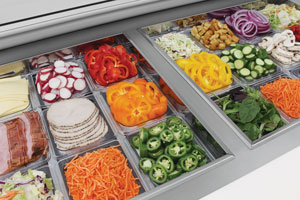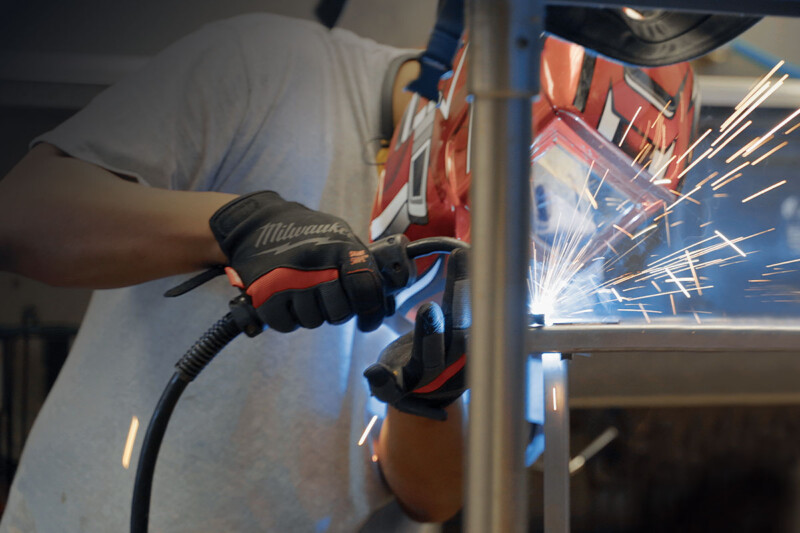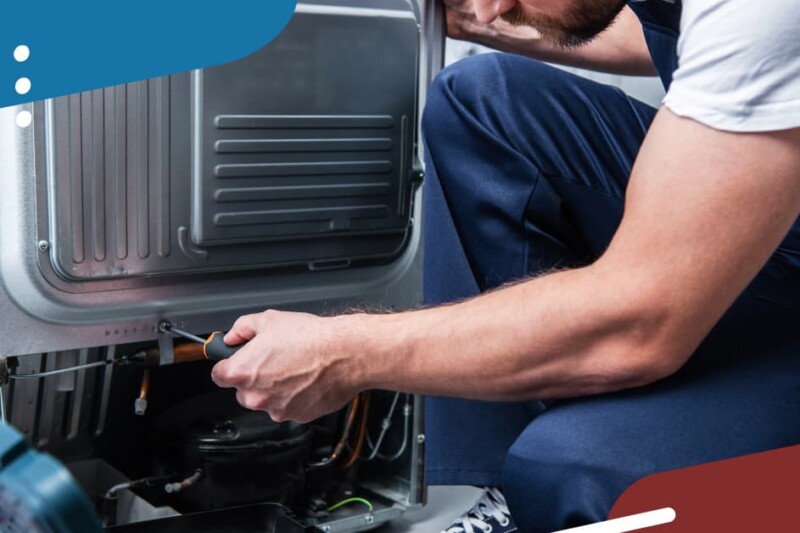Care & Maintenance: Prep Tables

During food prep, the safety and freshness of your ingredients depends on a prep table that’s in working order. Prep tables come in myriad styles, with work counters or cutting boards, door- or drawer-style storage below, assorted configurations with barriers between the bins up top and the cold storage below and different refrigeration systems. Despite the options and setups, cleaning and maintenance tips are fairly uniform.
Daily Cleaning
Depending on the unit, you may need to start by covering and storing the ingredient pans. Next wipe down the unit with water and a mild detergent solution every day. To clean the cutting boards or work counters, wipe them clean and sanitize them according to local health code requirements. If you can remove the board and wash it in a three-compartment sink or dish-machine, that’s a thorough approach. Read the operator’s manual to determine the best strategy.
Wipe out the emptied bin wells and thoroughly clean the door and/or drawer gaskets. Cleaning the holding area is critical; health inspectors will check them.
Periodic Upkeep
If you don’t clean your condenser coil every three to six months, you are working your prep table into an early grave. The condenser coil, usually accessible on one side or another in the back, easily gets coated with dust, debris, plastic wrap and other blockages that prevent it from transferring heat out to keep cold in. Some units have filters that protect the condenser that can be removed, cleaned and reinstalled. These filters extend the time between coil cleanings, according to the manufacturers, but they don’t eliminate the need to clean the condenser itself altogether. Properly cleaning a condenser coil typically involves the following steps:
• Assemble your cleaning tools: soft bristle brush, tarp, shop vac, compressed air unit. You might want a face mask too. Remove open food from the area.
• Turn off and unplug the unit. Turn off the circuit breaker if necessary.
• Use a soft bristle brush to clean debris on the coil fins, being careful not to bend or damage the fins.
• Next, grab a shop vac hose and go over the entire condenser coil surface. Again, don’t dent or crush those fins; go easy.
• Whether you rent or buy, you’ll need a compressed air generator on hand to blow out the loosened particles and debris deep inside the condenser. You might want to wear a mask as dust and dirt will fly out of the side vents.
• Don’t use coil cleaning chemicals unless permitted by the manufacturer. Using products that are not approved could lead to permanent damage to metal components and void your product warranty.
Cleaning the condenser is not complicated, but if you can’t keep up with the task, hire a certified technician to come in and take care of it. They’ll use safe practices along with approved chemicals.
Notes On Gaskets
Be sure to regularly clean the door or drawer gaskets. Door gaskets were once difficult to keep clean, especially when it came to bacteria that lodged deep inside tracks. The gaskets were traditionally held in place by screws only or a bracket and screws. It often became the duty of maintenance staff to remove and replace these gaskets as needed. A whole custom gasket business developed out of this issue for virtually all refrigeration and freezer products.
In response, manufacturers have either redesigned the gasket holding method to make it easier to replace them, made wider gaskets (a larger surface better holds the door closed) or moved to using magnetic gaskets that snap in and out as alternatives. Some prep-table makers design gaskets that you can remove and put through a dish-machine. You need to check this though, because some of today’s high-temp machines are very high temp and may damage the gasket material.
Gaskets will wear out, and as they are the keepers of the seal that keeps hot air out and cold air in, they will have to be replaced. If they are filthy, coming off, bulging, gapping or cracked, you need to replace them. Use the model number on the prep table to order the right gaskets. And take care during the cleaning and replacement process; operators report losing gaskets after cleaning, putting the wrong gasket on a door or drawer so they don’t really fit or seal right, and forgetting to replace them at all. In any of these situations, the temperatures will rise.
Ongoing Use
Temperatures will rise too if you or your employees leave doors open, fail to clean the condenser coil and gaskets and leave holes in the ingredient bins up top.
Not using all the space on the cold rail with product pans is like leaving the door open; you’re leaving a big hole for hot air to get in and the unit can’t maintain temperature. When a prep table has to work too hard to maintain temperature, it can freeze up and freeze ingredients. Using the wrong size pans in the top rails or even worse, placing a hot food in those pans will throw the temperature into a tailspin. Makers designed ingredient bins to hold cold foods cold, not chill cooked foods.
Looking Ahead
Manufacturers keep track of common user errors, and have developed the next generation of technological solutions to keep prep tables working well such as the use of Wi-Fi and Bluetooth signals to remotely monitor—and in some cases, adjust—temperature settings. Look for more use of digital and touchscreen controllers that integrate sensors that allow for more precise temperature settings. Coming up, more units will leave a digital history of the unit, including when a door was left open or when the unit entered into refrigeration cycles. This new technology will help identify bad practices, help save food inventory, and assist technicians in accurately identifying problems for faster first-time fixes.
RELATED CONTENT
- Advertisement -
- Advertisement -
- Advertisement -
TRENDING NOW
- Advertisement -
- Advertisement -
- Advertisement -


